|
Fujitsu LifeBook T4410
Multi-touch capable Tablet PC convertible with Windows 7 offers
both performance and long battery life
by Conrad H. Blickenstorfer
On October 19, 2009, Fujitsu introduced the Windows 7-powered LifeBook T4410 Tablet PC as an affordably priced notebook convertible, i.e. a computer that can be used both as a standard laptop but also as a Tablet PC slate. To go from one to the other, you simply rotate the display around its single-point pivot and then fold it flat down on top of the keyboard part of the computer, LCD facing up. Thanks to the friendly help of Fujitsu's Wendy Grubow in making a review machine available and a lenghty conversation with Paul Moore, who is Senior Director of Mobile Product Development at Fujitsu (read conversation), RuggedPCReview.com can now offer an educated opinion on the Lifebook T4410.

The T4410 is available either with a standard electromagnetic digitizer or with a dual input system that uses both an electromagnetic digitizer and a capacitive multi-touch screen. Starting at just under 4 pounds with the standard 6-cell battery, the T4410 is still light enough to be carried around and used in tablet mode. There are three processor choices, all offering considerable performance while still allowing decent battery life of up to 5.5 hours, and over 9 hours with the optional secondary battery that takes the place of the optical drive in the T4410's drive bay.
The T4410 has a 12.1-inch display with the now almost standard wide aspect ratio 1280 x 800 pixel format. Customers can order the T4410 either with a 200 nit LED backlit LCD, or an optional wide-viewing angle display with 300 nit backlight and viewing angles of over 160 degrees (highly recommended).
On the storage side, you can get 5400rpm SATA 150 drives up to 320GB, a speedy 7,200rpm 160GB drive, or a 64 or 128GB SSD drive. The modular bay can accommodate a dual-layer multi-format DVD Writer.
Connectivity is quite good. There are three USB ports, a IEEE1394 "Firewire" port, gigabit Ethernet, a 54mm ExpressCard slot, an HDMI port for high-definition TV connectivity, and a shared Memory Stick/SD card reader. No more modem port (who needs it?), but you get a 2-megapixel webcam. An optional port replicator adds more USB ports and a DVD-D port.
What you get with the Fujitsu Lifebook T4410
What do you get with the Fujitsu Lifebook T4410? That would be a tried-and-true 11.7 x 9.2 inch Tablet PC convertible notebook made by one of the world's most experienced vendors of Tablet PC technology. The machine is an inch and a half thick and weighs about 4.5 pounds equipped with the standard battery and an internal optical drive. You get a wide-format display that is large enough and has high enough resolution, a full-size and very businesslike keyboard so that your hands and fingers do not have to adjust to a slightly downsized version, excellent performance, and amazingly good battery life.
The display, which supports both multi-touch and an electromagnetic digitizer and automatically switches between them, measures 12.1 inches diagonally and uses the popular 1280 x 800 pixel wide format. Our review unit came with the optional daylight-viewable version that has a bright 300 nit LED backlights and very wide viewing angles in all directions.
As you can see in the composite image below, the Lifebook T4410 is a representative of the convertible Tablet PC concept that, in its present form, has been around since early 2002.
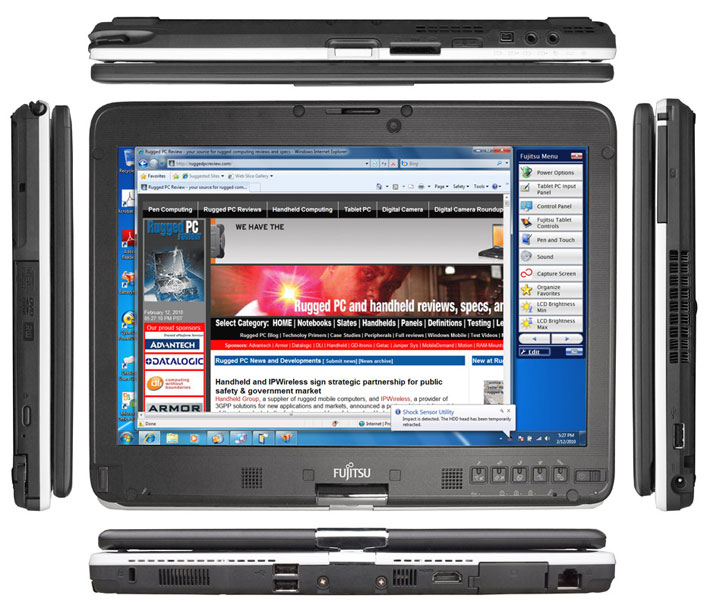
On the left side are:
- a USB port
- a ExpressCard slot
- a USB port
- the air vent for the fan/heat exchanger
- the power jack
On the right side you find:
- the optical drive
- a garage for the active pen
On the backside are: 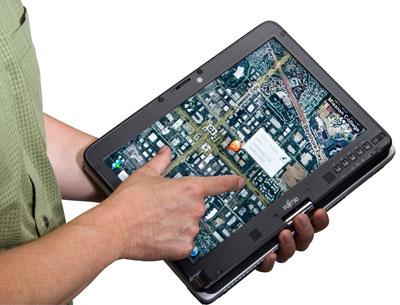
- a Kensington hardware lock slot
- more heat vents
- an RJ45 LAN connector
- a USB port
- a HDMI port
On the front are:
- a microphone jack
- a headphone jack
- an RJ45 LAN connector
- a wireless on/off slider
- a SD Card/Memroy Stick multi card reader
Below the display are:
- two speakers
- the on/off switch
- five Tablet PC hardware buttons
- a Fingerprint sensor
- an ambient light sensor
The full-size 84-key keyboard has light-gray keys with clear dark-gray writing for primary symbols and smaller markings for the two dozen or so function key operations (including a numeric keypad). The keyboard is well organized and provides good tactile feedback.
For cursor control and navigation, the Lifebook T4410 has a touchpad with mouse buttons and an integrated scroll sensor in addition to touch and pen. There are also five additional Tablet PC buttons next to the power switch with its bright blue illumination:
- Screen rotation (standard, -90 degrees)
- Windows security button (to switch users, log off, lock, or start the Task Manager)
- Two programmable application launch buttons
At the bottom left of the LCD display is a biometric fingerprint reader, on the bottom right a battery of status lights (Security, NumLock, CapsLock, ScreenLock) and an ambient light sensor.
Along the left front edge of the main body is a battery of seven indicator lights (power, external power, drive access, battery 1 charging and level, battery 2 charging and level).
The Lifebook T4410 is a highly functional tool for the job rather than a sleek exercise in avant-garde design, nicely finished in black and silver, and adorned with a good half dozen plastic stickers indicating what all is inside. The case is solid and trust-inspiring, as one would expect from a company that's now in 40th generation of pen technology products. Everything's right, everything makes sense, everything's there because it needs to be there, and not just because it looks good. The LCD case easily snaps into a lock so that it won't open inadvertently, and it just as easily releases with the slight push of a button. The lock latch rotates so that it can perform its locking duty with the display facing up or down. Oh, and the rotating display rotates a full 180 degrees BOTH WAYS and not just clockwise like almost all competition. A small thing perhaps, but very useful.
The bottom allows access to the battery compartment, a docking connector and the memory expansion compartment that houses two memory card slots that use 1066MHz DDR3 memory modules. There's also a removable dust filter that's easily cleaned. Anyone who ever had a notebook dying due to overheating will greatly appreciate this simple, clever way of keeping things clean and cool inside this Lifebook.
Performance and battery life
For most notebook computers, and tablets and ultralights in particular, the design goal is to find an acceptable compromise between best possible performance and acceptably long battery life. In general, faster processors need more power, which means a larger battery, which means higher weight. For mobile computers that will most of their time in the field and away from power outlets, designers will probably pick a low power processor that still delivers acceptable performance. Interestingly and perhaps tellingly, that is NOT what Fujitsu did when selecting the engines for the Lifebook T4410, and certainly not for our review model that came with an Intel Core 2 Duo P8700, a rather powerful dual core processor using 45 nanometer lithography and running at a brisk 2.53GHz. Thermal design power (defined as the maximum amount of power a computer's cooling system needs to dissipate, and used by Intel as a measure of power efficiency) is 25 watts, only a fraction of what more desktop-oriented mobile processors use, but still quite a bit more than your average low-power chip and certainly a lot more than the Atom processors populating all those millions of netbooks.
We benchmarked the Lifebook T4410's performance with Passmark Software's PerformanceTest 6.1 that runs about 30 tests covering CPU, 2D graphics, 3D graphics, memory, and disk and then computes scores for each category and an overall PassMark score. For comparison we added the results of other recent entries into the business-rugged market, the Getac 9213 and the Dell XT2 Tablet PC convertible that both use the significantly more frugal SU9400 processor. The benchmark results are as follows:
|
PERFORMANCE
|
Fujitsu T4410
|
Dell XT2
|
Getac 9213
|
|
Processor
|
2.53GHz Core 2 Duo P8700
|
1.4GHz Core 2 Duo SU9400
|
1.4GHz Core 2 Duo SU9400
|
|
Thermal Design Power
|
25 watts
|
10 watts
|
10 watts
|
|
CPU Mark
|
1579.8
|
864.0
|
838.4
|
|
2D Graphics Mark
|
256.3
|
182.1
|
176.0
|
|
Memory Mark
|
615.9
|
356.3
|
347.9
|
|
Disk Mark
|
493.8
|
465.4
|
390.2
|
|
3D Graphics Mark
|
170.4
|
107.9
|
102.1
|
|
Overall PassMark
|
716.6
|
428.9
|
403.9
|
|
BatteryMon Power Draw
|
9.9 watts
|
8.9 watts
|
6.2 watts
|
The results are telling. While the power-conserving Core 2 Duo SU9400 processor used in the comparison products provides very good performance and is at least twice as fast as your standard Atom-powered netbook, it's no match for the higher-powered P8700 rumbling under the hood of the Lifebook T4410. That was to be expected, and it clearly shows that Fujitsu was not willing to compromise performance with this Lifebook.
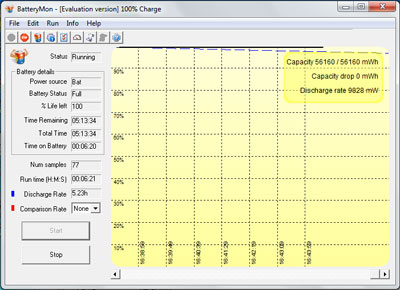 But how about battery life in such a powerful machine? The specifications on Fujitsu's website indicate up to 5 hours and 25 minutes with the standard 6-cell 56 watt-hour and a full 9 hours and 10 minutes with the optional media bay battery installed as well. Our review unit had the standard battery and we used Passmark Software's BatteryMon to determine power draw. But how about battery life in such a powerful machine? The specifications on Fujitsu's website indicate up to 5 hours and 25 minutes with the standard 6-cell 56 watt-hour and a full 9 hours and 10 minutes with the optional media bay battery installed as well. Our review unit had the standard battery and we used Passmark Software's BatteryMon to determine power draw.
Well, in power savings mode and with the backlight turned down so just could just still see the display, power draw was between 10 and 11 watts and occasionally fell into the 9 watt range! With its 56 watt-hour battery, that translates into well over five hours of run time. That is an excellent result, with idle draw barely above some of the Atom systems we've tested, and also not that much more than the much more modestly powered comparison systems.
Display
While Fujitsu does not make any ruggedness claims or targets the Lifebook T4410 to any particular vertical markets, it's clear that this is a machine that can be used in a variety of outdoor and mobile applications. Which means its display should remain viewable outdoors and even in direct sunlight, and Fujitsu made sure that it does. As a result, Fujitsu offers the T4410 both with a standard display and with an optional one that has a brighter (300 nits versus 200 nits) backlight and wide viewing angles for better outdoor visibility. In addition, the T4410's display has a semi-matte finish instead of one of those ultra-glossy surfaces that supposedly "pop" more when viewing movies. Well, this is a machine for real work, and I much prefer its nice, matter display.
The picture below shows the Fujitsu Lifebook T4410 sitting next to an older but very competent Gateway notebook we're still using around the office. The picture was taken outdoors in the shade on a bright, sunny afternoon. As you can see, the Fujitsu's LED-backlit display is somewhat brighter than the Gateway with its standard backlight and its matte surface totally eliminates the clearly visible reflections on the other computer's glossy screen.

Below, the two machines are sitting in the same spot with the picture is taken from a lefthand angle. The anti-glare properties of the Fujitsu display make it a little milky but there are no reflections at all and the display remains readable. The glossy comparison display has so much reflection as to render it useless.
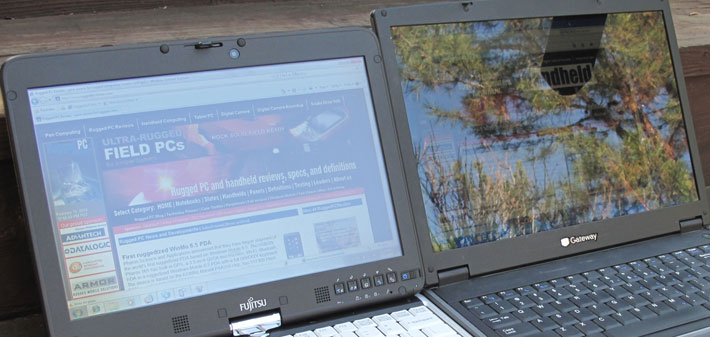
Same story with a picture taken from the right. The Lifebook display's anti-glare treatment make it a bit milky but it remains readable whereas the almost mirror-like gloss of a standard display causes enough reflection to make the screen useless outdoors. I cannot overstate the importance of this. The human brain has a tendency to fill in blanks, and even minor reflections can become major irritants as the brain seeks to complete the reflection and it then becomes competition with what's actually on the display. I much prefer Fujitsu's matte filter.
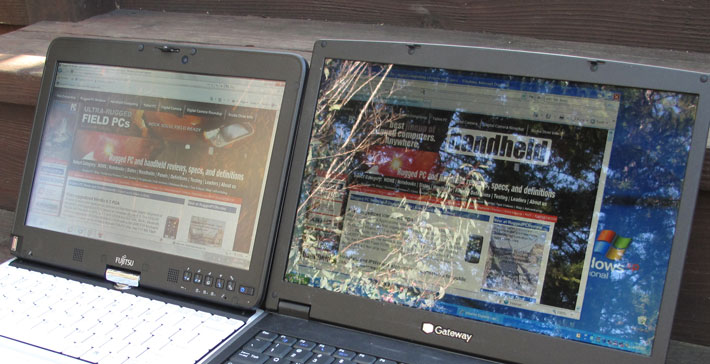
Dual digitizer system available
Ever since the very dawn of pen computing two decades ago, almost every pen-based system has been using the ubiquitous Wacom digitizer. It's a mature system that works well and uses a slender pen that does not need its own battery. However, there are often situations where touch is also desirable or even preferable. And as of late, there's been much demand for multi-touch systems capable of doing some of the fancy footwork the Apple iPhone is famous for.
With the T4410, Fujitsu covers all bases by offering versions with just the Wacom digitizer and also versions that come with both the Wacom digitizer and a projected capacitive touch screen capable of multi-touch input. This way, the T4410 can be used with applications where touch is the best input method, and other application where the precision and cursor-tracking of an active digitizer works best. Dual digitzers are fairly common in vertical market tablets, but rare in consumer and business systems, and we're just now seeing systems that offer a digitizer and multi-touch.
How does it all work? Beautifully. In its default configuration, a dual digitizer-equipped T4410 accepts both touch and pen input simultaneously. However, to avoid "spiking" -- a situation where you want to use the pen but the system might misinterpret the pressure of your palm against the display as touch input -- touch is turned off as long as the computer detects the proximity of the pen.
Pen and Multi-Touch functionality
In the Fujitsu 4410, the Windows 7 "Pen and Touch" panel now includes five tabs as follows:
Handwriting recognition
There was a time when handwriting recognition was considered the centerpiece of pen and tablet computing. It was emphasized how everyone knows how to use pen and paper whereas far fewer are proficient with a keyboard. Alas, back then (in the early and mid 1990s) handwriting recognition didn't work nearly well enough to reliably recognize the vast variety of writing styles and so, after an initial period of enthusiasm, was widely dismissed.
Well, Microsoft has quietly improved recognition over the years, and the Input Panel and recognition engine included in Windows 7 works amazingly well. You can now even do something which the old Apple Newton MessagePad introduced, and that is scratching out a word, the way we all do when we write on paper. So those who try handwriting reco will be in for a pleasant surprise.
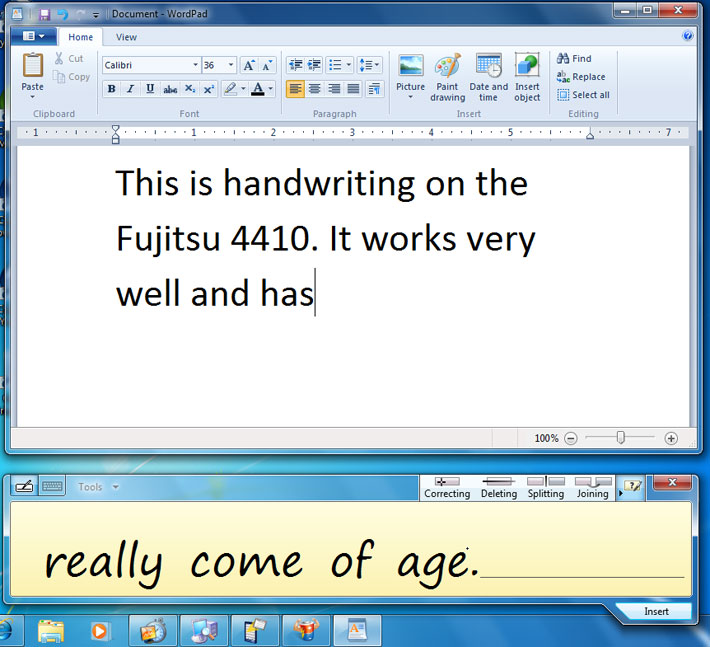
There's even a special Math Input Panel that easily recognizes high school and college-level math , including Calculus and some pretty advanced notations. That, too, works very well.
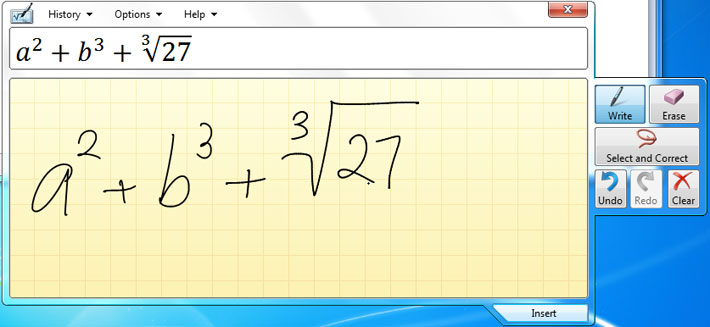
The latest implementation of the clever Snipping Tool is much quicker and less intrusive than prior versions and easily lets you quickly snag part of a page, screen or window and then annotate it with ink before saving it as a PNG, GIF or JPG file or emailing it somewhere. Below is a picture of a snippet of text from a webpage that was captured and then annotated for discussion.
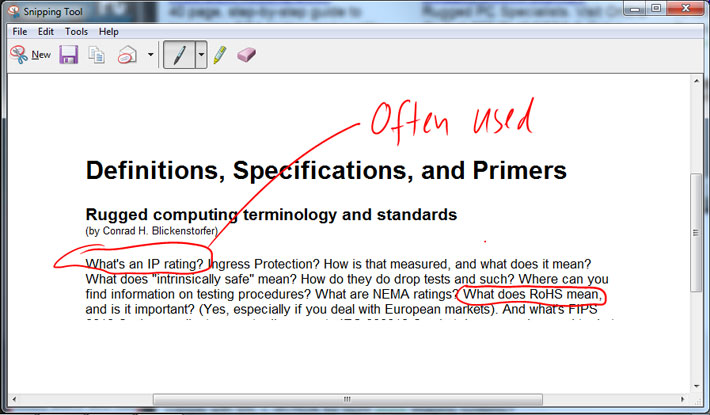
Windows Journal is also still there, and it is the same competent (though often overlooked) "ink processor" it's always been (yes, it's been around for almost 15 years). It's not for everyone, but for those who like to quickly jot down some ink notes and doodles, it can be an invaluable productivity tool.
Also included is a Touch Pack for Windows 7 that includes a few games and utilities, including the pretty impressive Microsoft Surface Globe where you can pinch, rotate, and pan a world map to your heart's content, sort of like what more and more TV News people do with their maps. On the Lifebook 4410 this all works quickly and flawlessly, coming much closer to the super-smooth, effortless way things happen on an iPhone.
One problem, and it's a problem virtually all Windows-based tablets are afflicted with, is that all of this in part very impressive pen and touch functionality is tucked into various nooks and crannies of the system where it's often hard to find, sometimes so hard to casual users will never find it. Another problem, also endemic in Windows-based systems, is the endless variety of panels and pop-ups and settings and tools to configure things, with Microsoft and third party tools overlapping. As a result, the cohesive simplicity of an iPhone where everything simply works is replaced by numerous tools that can all be used to give a Windows computer pen and touch capabilities without ever truly making things simple and intuitive. This is too bad as the Lifebook T4410 offers superb technology.
Bottom line
The Fujitsu Lifebook T4410 is a very functional, very mature full-featured Tablet PC convertible from the company that practically wrote the book on pen-enabled notebook and slate computers. The dual mode digitizer with its multi-touch capability works quite well and Windows 7 has added some interesting new features. The Lifebook T4410 is technologically up-to-date (though for now it sticks with economical Core 2 Duo processors rather then Intel's new Core i5/i7 chips) and, unlike some machines in its class, comes with a media bay that can be used for an optical drive or an optional second battery.
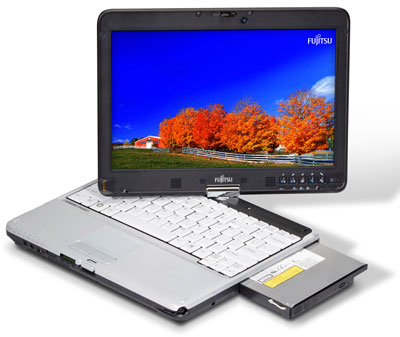 Fujitsu also did not compromise on performance. The T4410 comes with a choice of powerful Intel processors, all the way up to powerful 2.8GHz Intel Core 2 Duo P9700 processor. Our test machine came with a 2.53GHz P8700 processor that provided both excellent performance and amazingly good battery life (over 5 hours). Equipped with an optical drive and the battery installed, the T4410 weighs 4.5 pounds; no lightweight, but quite acceptable. There's an onboard camera for video conferencing and there is plenty of onboard security, including a fingerprint scanner. Fujitsu also did not compromise on performance. The T4410 comes with a choice of powerful Intel processors, all the way up to powerful 2.8GHz Intel Core 2 Duo P9700 processor. Our test machine came with a 2.53GHz P8700 processor that provided both excellent performance and amazingly good battery life (over 5 hours). Equipped with an optical drive and the battery installed, the T4410 weighs 4.5 pounds; no lightweight, but quite acceptable. There's an onboard camera for video conferencing and there is plenty of onboard security, including a fingerprint scanner.
The 12.1-inch display offers 1280 x 800 pixel wide-format resolution. The version on our review machine had the bright 300-nit display with very effective anti-glare coating and very wide viewing angles from all sides.
For wireless communications, there's Bluetooth V2.1 and your choice of integrated Intel or Atheros modules supporting 802.11a/n.
Unlike most convertibles and lightweight notebooks, the T4410 is reasonably priced. It starts at US$1,199 and dual digitizer versions start at US$1,299. That is less than the lighter Lifebook T2020, but still more than most notebooks in this era of ever-lower laptop prices.
Overall, the Fujitsu T4410 is a workmanlike but eminently capable tool for the job. It can be used both as a notebook and as a tablet, and its balance between strong performance and good battery life makes it as useful in the field as in the office.
-- Conrad H. Blickenstorfer
Fujitsu Lifebook T4410 Specs:
| Type |
Tablet PC convertible
|
| Processor |
Intel Core 2 Duo P8700 or P8800 with 3MB L2 cache or P9700 with 6MB L2 cache, all 1066MHz FSB
|
| CPU speed |
2.53, 2.66, 2.80 GHz
|
| Chipset |
Mobile Intel GM45 Express and ICH9-ME
|
| OS |
Windows 7 Professional and downgrade to Windows XP Tablet PC Edition 2005
|
| Memory |
Up to 4GB DDR3 1066MHz in two slots |
| Display |
12.1" 1280 x 800 pixel WXGA LCD with 300 nit LED backlight bright display with 160 degree horizontal and vertical viewing angle; 200 nit standard display also available |
| Digitizer |
Electromagnetic or dual digitzer (electromagnetic pen and capacitive multi-touch) |
| Keyboard |
84-key full-size, spill-resistant keyboard (19 mm key pitch, 3.0 mm key stroke); touch pad with scroll sensor |
| Storage |
160 GB (Optional full data encryption) 250 GB, 320 GB (5400 rpm), 160 GB (7200 rpm) SATA 150, shock-mounted hard drive; 64 GB, 128 GB Solid State Drive
|
| Optical Drive |
Modular Dual-Layer Multi-Format DVD Writer
|
| Expansion slots |
ExpressCard slot for one 34 or 54mm ExpressCard, Memory Stick/SD Card slot
|
| Housing |
unknown |
| Size |
11.7 x 9.2 x 1.5 inches |
| Weight |
4.5 pounds as tested (with battery and optical drive)
|
| Operating temperature |
41-95F |
| Humidity |
20-85% relative, non-condensing |
| Operating altitude |
10,000 feet |
| Ingress protection |
unknown |
| Drop |
unknown |
| Vibration |
unknown |
| Power |
6-cell Li-Ion 10.8 Volt 5,200mAH 56 watt-hour ("up to 5.4 hours"); optional 10.8 Volt 3,800mAH Li-Ion media bay battery ("up to 9 hours") |
| Interface |
3 USB 2.0, IEEE1394, HDMI, RJ45 (gigabit), 2 megapixelWebCam |
| Wireless |
Audio, Atheros XSPAN 802.11b/g/n or Intel WiFi Link 5100AGN or 5300AGN, video, fingerprint reader, Bluetooth v2.1
|
| Price |
From US$1,199
|
| Contact |
store.shopfujitsu.com.com |
(copyright 2010 RuggedPCReview.com)
|



